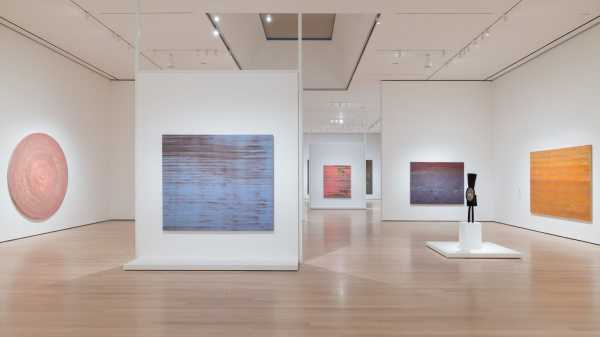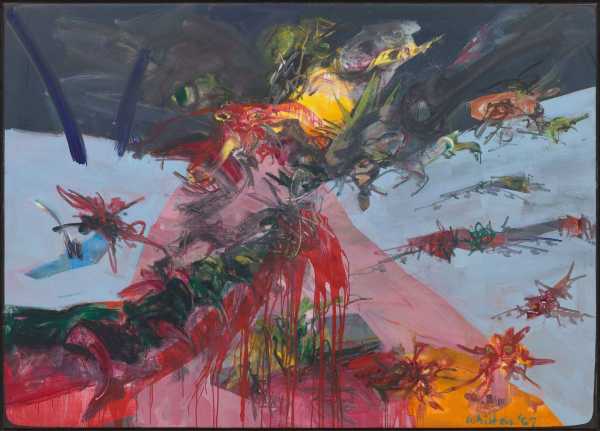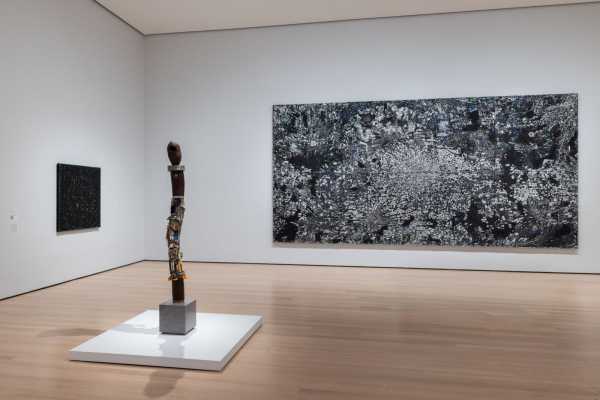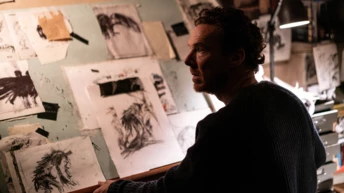
Save this storySave this storySave this storySave this story
He poured the paint in layers and combed through it with an Afro pick. Or he froze and shattered it, reassembling the shards into new wholes. Like an alchemist, he altered its consistency with precisely calibrated tinctures. Like a hoodoo man, he infused it with ash, blood, and fragments of bone. His studio on Lispenard Street, in Tribeca, was full of contraptions, and his notebooks boiled over with a mad scientist’s exuberance. “TRUTH IS A PROCESS OF ELIMINATION” he exults in one entry; in another, a transformative residency at Xerox sparks an outburst of gospel: “I am on my way to glory / a child of the plane.” In the nineteen-nineties, he attained that glory with the invention of his “tesserae” paintings, arranging bits of hardened acrylic into glittering free-form mosaics. One called “Black Monolith II (For Ralph Ellison)” confronts you as you enter “The Messenger,” his new MOMA retrospective—a dark apparition checkered with iridescent squares, suggestive of a man’s silhouette, with a small razor where you’d expect a mouth.
Jack Whitten made it his life’s mission to give abstraction soul. “I believe that there are sounds we have not heard,” he once said. “I believe that there are colors we have not seen. And I believe that there are feelings yet to be felt.” He proved it again and again, from the sixties, when he distilled the anger and yearning of the civil-rights struggle into the language of abstract expressionism, to his death, in 2018, just three years after Barack Obama presented him the National Medal of Arts. The MOMA exhibition throws new light on his celebrated tesserae works—such as his twenty-foot-wide tribute to the victims of the 9/11 attack on the World Trade Center, which he witnessed—by presenting them as the capstone to a lifetime of experimentation. It’s a breathtaking, deeply researched glimpse of a career that unfolded in one long eureka.
Whitten reconciled creative impulses that often seemed diametrically opposed. Michelle Kuo, who organized the show, argues in the catalogue that Whitten created a third abstraction between “gestural painting and the grid,” synthesizing Jackson Pollock and Piet Mondrian. He approached painting like science, but also flirted with spiritualism, drawing inspiration from African sculpture’s ritual efficacy. Perhaps the greatest contradiction he overcame was being a Black artist who didn’t practice figuration—a position anathema, in his early years, to both sides of the art world’s color line. In all of this, his lodestar was jazz, which he unsuccessfully pursued as a tenor saxophonist before adopting it as a philosophy. Devoted to the music’s experimentalism, its blend of composition and improvisation, and its universalism rooted in African American particularity, he’s the rare Black artist for whom the analogy is more than a reductive cliché.

“Black Monolith VII, Du Bois Legacy: For W.E. Burghardt” (2014).Photograph by Jonathan Muzikar / The Museum of Modern Art, New York
Near the exhibition’s entrance is “Homecoming: For Miles” (1992), a painting whose hundreds of square-shaped acrylic tesserae evoke a pixelated grayscale image of the cosmic microwave background. Nebular patches alternate with blotches of jet; just visible in the foreground is a circle of white dots crossed with lines that meet at its center, like a spoked wheel of stars. The painting is an elegy for Miles Davis, and though no album is specified, I was immediately reminded of “In a Silent Way,” the hypnotic record—all brushed drums and stellar synths—that marked the beginning of Davis’s fusion era. Jazz purists complained that its edited loops and electrified instruments were a violation of the genre’s integrity. Yet what he’d really done was create a symbiosis between spontaneity and system, using recorded improvisation as material.
“Homecoming” was constructed similarly. Whitten poured out a layer of black paint; spattered it, haphazardly, with white dots; let it dry; and then used a razor to cut the resulting sheet into tiles. Only then did he fashion a universe from these units of randomness. “Space is not a place,” he’d once written, cryptically, in a studio log. Was it an allusion to Sun Ra, who’d said that it was? A comment on the paint’s illusionism, the conjuring of infinite depths on a wafer-thin slice of acrylic? Perhaps he meant that space was a state of mind, an act of will, a command one could give oneself—as he wrote, alluding to “Star Trek,” at the end of one of his long lists of aspirational commandments: “Number one, ‘Make it so!’ ”

Installation view of “Jack Whitten: The Messenger,” on view at the Museum of Modern Art.Photograph by Jonathan Dorado / The Museum of Modern Art, New York
Whitten was an artist who looked relentlessly forward, and his origins explain why. He was born in Bessemer, Alabama, a coal town, in 1939, at the height of Jim Crow. His father worked in the mines. His mother was a seamstress, whose deceased first husband had been a sign painter; Whitten inherited his tools. He studied at Tuskegee Institute, intending to become a doctor, before transferring to Southern University, where he not only discovered his artistic vocation but also organized civil-rights marches. The struggle is inescapable in his early work. “Birmingham 1964,” an assemblage, takes the form of a jagged circular gape in blackened aluminum foil. Underneath are layers of newspaper clippings about racist terrorism, with a silk stocking stretched over them—an allusion to the girls murdered in the Sixteenth Street Baptist Church bombing.
He had already escaped from the South by matriculating at Cooper Union, in 1960. In New York, he worked on construction sites, made advertisements for retailers, and embraced the “paint-slinging” style. Huge, explosively colorful canvases, including “NY Battle Ground” (1967) and “King’s Garden #4” (1968)—part of a series dedicated to Martin Luther King, Jr., whom he’d met in Alabama—gave vivid expression to the era’s turmoil. Yet despite the efforts of Whitten and a few fellow-travellers, such as Norman Lewis and Alma Thomas, formalist ideals and Black politics were oil and water. “The white community, they would just say, ‘Ah, they’re aping white artists,’ ” Whitten recalled. “And from the Black community, ‘Oh, they’re not doing Black art with Black people, so why bother?’ ”
One look at “Atlantis Rising” (1966), executed in broad, chaotic brushstrokes of grayish black, dark violet, and slate blue, is enough to refute both charges. The painting conjures a roiling ocean, as though Whitten—who later became a scuba diver, and enjoyed hunting octopuses—were envisioning a doomsday resurrection of the Middle Passage dead. Nevertheless, he became disenchanted with abstract expressionism, which he began to see as nostalgically tethered to the painter’s touch in a rapidly mechanizing world. For “Light Sheet I” (1969), he constructed a pulley system to screen-print paint through stencils onto an enormous canvas, creating a portal-like pattern of concentric squares in hallucinatory pink and yellow. (It was inspired by a conversation with John Coltrane, whose rapidly stacked chords were known as “sheets of sound.”) Whitten transformed his studio into what he called a “laboratory,” deciding that he would stop painting and start “making paintings.”
He radically pared back his compositions. “I just want a slab of paint,” he decided in 1970, when he built a platform on the floor of his studio and began emptying gallons of acrylic directly onto the canvas. The kaleidoscopic palette gave way to largely monochrome works such as “Four-Wheel Drive”—a striking, circular painting that evokes a vinyl record cut from rose quartz, with a spiral of grooves radiating from its center. Whitten etched them with one of several custom-built tools that he dubbed Developers. Having carefully poured his paint, often in layers of varying hues, he’d drag the instrument over it, “developing” his image in a stroke.

“NY Battle Ground” (1967).Photograph by Jonathan Muzikar / The Museum of Modern Art, New York
A Developer leans against a wall in the exhibition—a man-size plywood trident with a long metal beam across its end. Sometimes Whitten would connect one to a squeegee, a carpenter’s saw, or other improvised extensions to produce different effects. The results give a dazzling, simultaneous impression of serenity and velocity—half zen garden, half hyperspeed blur. “Golden Spaces” (1971) is a smog-wreathed horizon at sunset; “Siberian Salt Grinder” (1974) is a sombre rainbow rewound by a malfunctioning VHS player. Whitten didn’t so much streamline his colors as bury and stratify them, “excavating” vivid streaks from beneath the monochrome surface. For the pyramid-shaped “Homage to Malcolm” (1970), which uses depth of paint as a metaphor for memory, he combed through thick black acrylic in patterns reminiscent of basketry to reveal pan-African flashes of green, blackish blue, and ember-like red.
The “slab paintings” swelled in size and complexity, becoming as elaborately colored as the twelve-layer kimonos of court ladies in tenth-century Japan. Whitten adulterated his acrylics to control the interplay between levels, achieving “a virtuosic calibration of drying times, translucent gels, and wet-on-wet application,” in Kuo’s words. He liked to forget which color was underneath which, cultivating an element of chance that he intensified by littering the paint with “disruptors.” These were pieces of bric-a-brac, such as staples, wire, coat hangers, and string, that added unpredictable marks; eventually, he all but stopped using chromatic colors and focussed entirely on surfaces and textures, mimicking cathode-ray-tube television scan lines in a series named after the letters of the Greek alphabet.
It was as though he were searching for a new language upon which to ground his work. Every summer in Greece, where his wife’s family originated, he made sculptures in wood, metal, and found materials, taking inspiration from Cycladic figurines and African statuary, which he called the “DNA” of all art. (Several are on display.) At Xerox, he experimented with making drawings by tossing dry toner. After a fire destroyed his studio, in 1980, he changed his practice even more dramatically, experimenting with a technique that used plaster of Paris to cast molds of found objects—trees, manhole covers, and even his own running shoes—which could then be filled with paint. All these tendencies converged in the tesserae: a “dry palette” of molded acrylic elements that could be mixed with found objects, enabling a fusion of painting and sculpture that defied the Western grid.

Photograph by Jonathan Dorado / The Museum of Modern Art, New York
Perhaps the most arresting sight in “The Messenger” is “Atopolis” (2015), an enormous eight-panel painting that Whitten made in honor of the Martinican philosopher Édouard Glissant. It heaves into view at the end of a long gallery filled with smaller tesserae works: a giant’s microchip, black and silver and crazed with tiny incisions, and studded with a macaroni of light-catching extrusions in jade and lapis lazuli. (Up close, you can detect such a range of textures that I was reminded of the draped bottle-cap sheets of El Anatsui, a sculptor as painterly as Whitten is sculptural.) Glissant is known for adopting the diaspora as a model for nonhierarchical thinking, and for arguing that the right to remain “opaque” is key to human freedom. It’s hardly surprising that Whitten devoted the largest of his paintings to him.
His earliest paintings had provided a counterpoint to the assertively bodily portraiture of the Black Arts Movement. Now, again, he showed that there were ways to visualize Blackness that extended beneath the skin. His approach seems only more prescient after the market collapse of the Black portraiture boom that crested in his final years; while Black figuration has been frequently appropriated as a signifier of radicalism or white-liberal tolerance, abstraction can operate in a more fugitive mode, defying reductionism by requiring viewers to draw on their imaginations.
Whitten’s dazzling series “Black Monoliths” is a gallery of great Black artists, writers, and political figures, whom it doesn’t so much represent as distill. W. E. B. Du Bois, the refined radical who believed both in a “talented tenth” and a global revolution against white supremacy, inheres in a work the shape of an oyster shell, whose complex loops and iridescent purple patches speak to his cosmopolitan vision of “The Souls of Black Folk.” Ornette Coleman, the free-jazz pioneer, inspires a splintered circle of multicolored squares against an inky wash of broad-brushed black and gray. The tesserae look as though they exist beyond time, simultaneously evoking L.E.D. displays and ancient Mixtec mosaic shields.
Across from “Atopolis,” near the exhibition’s exit, is a scrawny sculpture that Whitten titled “Technological Totem Pole.” It’s carved from a snaking mulberry branch and adorned with microchips, with a C.P.U. fan and a small desk clock embedded in the smoothly polished wood near its head. I couldn’t quite figure out if it was a monument to technology’s progress or an indictment of its folly. Suddenly, though, as I contemplated the sculpture’s “confrontation” with the painting, I felt that Whitten’s witchy handicraft abstractions—which affirm human particularity even as they embrace experiment—might be exactly what our A.I.-poisoned culture needs. “To all painters,” he wrote in 2016. “Let’s go where the computer cannot go.” ♦
Sourse: newyorker.com







